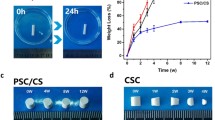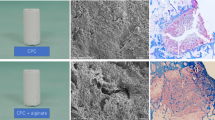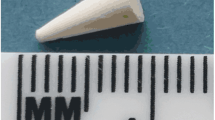Abstract
A composite bone cement designated G2B1 that contains β tricalcium phosphate particles was developed as a bone substitute for percutaneous transpedicular vertebroplasty. In this study, both G2B1 and commercial PMMA bone cement (CMW1) were implanted into proximal tibiae of rabbits, and their bone-bonding strengths were evaluated at 4, 8, 12 and 16 weeks after implantation. Some of the specimens were evaluated histologically using Giemsa surface staining, contact microradiography (CMR) and scanning electron microscopy (SEM). Histological findings showed that G2B1 contacted bone directly without intervening soft tissue in the specimens at each time point, while there was always a soft tissue layer between CMW1 and bone. The bone-bonding strength of G2B1 was significantly higher than that of CMW1 at each time point, and significantly increased from 4 weeks to 8 and 12 weeks, while it decreased significantly from 12 weeks to 16 weeks. Bone remodeling of the cortex under the cement was observed especially for G2B1 and presumably influenced the bone bonding strength of the cement. The results indicate that G2B1 has bioactivity, and bone bonding strength of bioactive bone cements can be estimated fairly with this experimental model in the short term.







Similar content being viewed by others
References
Charnley J. Anchorage of the femoral head prosthesis to the shaft of the femur. J Bone Joint Surg Br. 1960;42-B:28–30.
Freeman MA, Bradley GW, Revel PA. Observations upon the interface between bone, polymethylmethacrylate cement. J Bone Joint Surg Br. 1982;64:489–93.
Goldring SR, Schiller AL, Roelke M, Rourke CM, O’neil DA, Harris WH. The synovial-like membrane at the bone-cement interface in loose total hip replacements, its proposed role in bone lysis. J Bone Joint Surg Am. 1983;65:575–84.
Harper EJ. Bioactive bone cements. Proc Instn Mech Engrs. 1998;212:113–20.
Tamura J, Kitsugi T, Iida H, Fujita H, Nakamura T, Kokubo T, et al. Bone bonding ability of bioactive bone cements. Clin Orthop Relat Res. 1997;343:183−91.
Okada Y, Kawanabe K, Fujita H, Nishio K, Nakamura T. Repair of segmental bone defects using bioactive bone cement: comparison with PMMA bone cement. J Biomed Mater Res. 1999;47(3):353–9.
Kamimura M, Tamura J, Shinzato S, Kawanabe K, Neo M, Kokubo T, et al. Interfacial tensile strength between polymethylmethacrylate-based bioactive bone cements and bone. J Biomed Mater Res. 2002;61(4):564–71.
Goto K, Shinzato S, Fujibayashi S, Tamura J, Kawanabe K, Hasegawa S, et al. The biocompatibility and osteoconductivity of a cement containing beta-TCP for use in vertebroplasty. J Biomed Mater Res A. 2006;78(3):629–37.
Yoshii S, Kakutani Y, Yamamuro T, Nakamura T, Kitsugi T, Oka M, et al. Strength of bonding between A-W glass-ceramic and the surface of bone cortex. J Biomed Mater Res. 1988;22(3 Suppl):327–38.
Klaue K, Fengels I, Perren SM. Long-term effects of plate osteosynthesis: comparison of four different plates. Injury. 2000;31(Suppl 2):S-B51–62.
Uhthoff HK, Boisvert D, Finnegan M. Cortical porosis under plates. Reaction to unloading or to necrosis? J Bone Joint Surg Am. 1994;76(10):1507–12.
Fujita H, Nakamura T, Tamura J, Kobayashi M, Katsura Y, Kokubo T, et al. Bioactive bone cement: effect of the amount of glass-ceramic powder on bone-bonding strength. J Biomed Mater Res. 1998;40(1):145–52.
Kobayashi M, Nakamura T, Tamura J, Kikutani T, Nishiguchi S, Mousa WF, et al. Osteoconductivity and bone-bonding strength of high- and low-viscous bioactive bone cements. J Biomed Mater Res. 1999;48(3):265–76.
Senaha Y, Nakamura T, Tamura J, Kawanabe K, Iida H, Yamamuro T. Intercalary replacement of canine femora using a new bioactive bone cement. J Bone Joint Surg Br. 1996;78(1):26–31.
Takahashi A, Koshino T. Compressive and bone-bonding strength of hydroxyapatite thermal decomposition product implanted in the femur of rabbit as a bioactive ceramic bone cement. Biomaterials. 1995;16(12):937–43.
Lucksanasombool P, Higgs WA, Higgs RJ, Swain MV. Interfacial fracture toughness between bovine cortical bone and cements. Biomaterials. 2003;24(7):1159–66.
Author information
Authors and Affiliations
Corresponding author
Rights and permissions
About this article
Cite this article
Goto, K., Kawanabe, K., Kowalski, R. et al. Bonding ability evaluation of bone cement on the cortical surface of rabbit’s tibia. J Mater Sci: Mater Med 21, 139–146 (2010). https://doi.org/10.1007/s10856-009-3861-7
Received:
Accepted:
Published:
Issue Date:
DOI: https://doi.org/10.1007/s10856-009-3861-7




